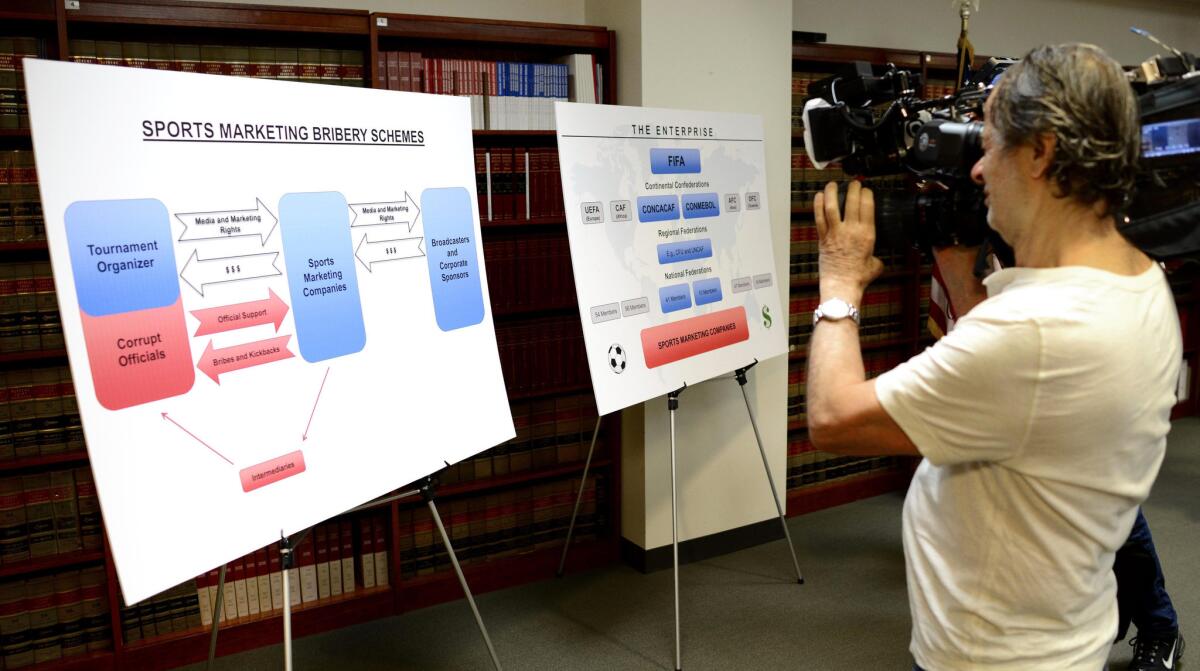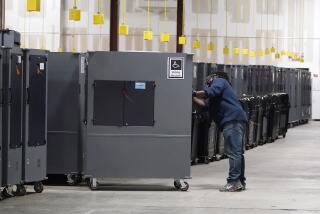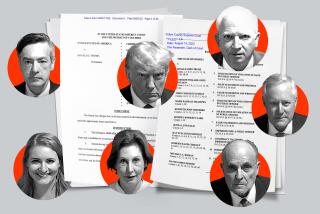FIFA corruption investigation details rate cards for bribery

A cameraperson shoots the boards detailing the charges against FIFA officials Wednesday in New York.
- Share via
The Justice Department on Wednesday unsealed its 165-page indictment alleging widespread corruption of top officials in FIFA, soccer’s world governing body. The case offers tantalizing allegations of what amounts to the current bribery rates for preferential treatment in international soccer.
Here are a few examples:
--In 2004, FIFA’s executive committee voted to award the 2010 World Cup to South Africa. Jack Warner, who was charged in the indictment, was then a member of the FIFA executive committee and head of CONCACAF.
Before the vote, FIFA also was considering World Cup bids from Morocco and Egypt.
“While in Morocco during the 2004 trip, a representative of the Moroccan bid committee offered to pay $1 million to WARNER in exchange for his agreement to cast his secret ballot ... for Morocco to host the 2010 World Cup,” the indictment said.
But, according to the indictment, Warner got a better deal: “The South African government, and the South African bid committee ... were prepared to arrange for the government of South Africa to pay $10 million” for his vote. “WARNER indicated that he had accepted the offer....”
Paying off the bribe wasn’t easy, according to the indictment: “Co-Conspirator #1 learned that the South Africans were unable to arrange for the payment to be made directly from government funds. Arrangements were thereafter made with FIFA officials to instead have the $10 million sent from FIFA” to a Bank of America account in New York “controlled by the defendant JACK WARNER, at Republic Bank in Trinidad and Tobago.”
--In 2013, Datisa, a new sports media and marketing firm, reached an agreement with the South American soccer federation (CONMEBOL) to pay $317.5 million for “exclusive worldwide rights” for the Copa America soccer tournaments in 2015, 2016, 2019 and 2023.
The indictment alleges how the payments were parceled out:
“Datisa agreed to pay $100 million in bribes to CONMEBOL officials -- all of whom were also FIFA officials -- in exchange for the 2013 Copa America contract: $20 million for contract signature and $20 million for each of the four editions of the tournament. Each $20-million payment was to be divided among the bribe recipients as follows: $3 million to each of the ‘top’ three CONMEBOL officials (the president of the confederation and the presidents of the Brazilian and Argentine federations); $1.5 million to each of seven other CONMEBOL federation presidents; and $500,000 to an 11th CONMEBOL official.”
--Brazil won the 1994 World Cup. Soon after, a major U.S. sportswear company began negotiating a new sponsorship agreement with “a high-ranking” South American soccer confederation and Brazilian soccer federation official, according to the indictment.
Two years later, a sponsorship deal was struck between the sportswear company (it was not named in the indictment was but revealed to a grand jury) and Traffic Group, a Sao Paulo-based sports marketing conglomerate. The sportwear firm agreed to to pay $160 million over 10 years to be the Brazilian soccer federation’s “exclusive footwear, apparel, accessories and equipment supplier.”
According to the indictment, the U.S. sportswear company also “agreed to pay a Traffic affiliate with a Swiss bank account an additional $40 million in base compensation on top of the $160 million it was obligated to pay” the Brazilian soccer federation. “Between 1996 and 1999, Traffic invoiced Sportswear Company A for $30 million in payments.”
Two Traffic executives, Aaron Davidson, a U.S. citizen, and Rafael Esquivel, a Venezuelan, were among the 14 charged in the indictment.
More to Read
Go beyond the scoreboard
Get the latest on L.A.'s teams in the daily Sports Report newsletter.
You may occasionally receive promotional content from the Los Angeles Times.











